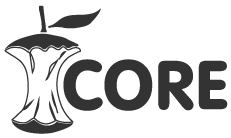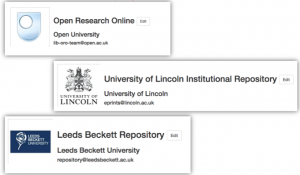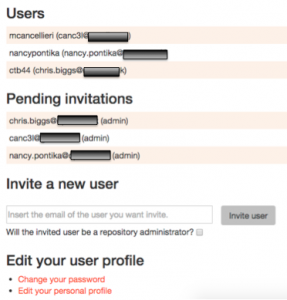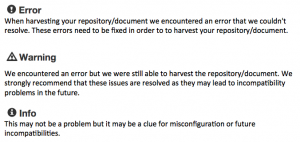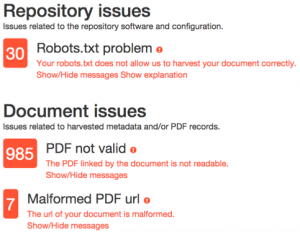In an effort to improve the quality and transparency of the harvesting process of the open access content and create a two way collaboration between the CORE project and the providers of this content, CORE is introducing the Repositories Dashboard. The aim of the Dashboard is to provide an online interface for repository providers and offer, through this online interface, valuable information to content providers about:
- the content harvested from the repository enabling its management, such as by requesting metadata updates or managing take-down requests,
- the times and frequency of content harvesting, including all detected technical issues and suggestions for improving the efficiency of harvesting and the quality of metadata, including compliance with existing metadata guidelines,
- statistics regarding the repository content, such as the distribution of content according to subject fields and types of research outputs, and the comparison of these with the national average.
In the CORE Dashboard there is a designated page for every institution, where repository managers will be able to add all the information that corresponds to their own repository, such as the institution’s logo, the repository name and email address.
The Dashboard allows repository managers to create accounts for other colleagues as well.
With regards to managing the harvested outputs, the Dashboard enables repository managers to add or remove documents’ full-text in the CORE collection without having to contact the CORE team.
These actions can now be completed immediately only by clicking on the “Take Down” or “Take up” buttons. It is also possible to download a CSV file of all the records harvested by CORE from a repository.
CORE can also be notified about metadata changes through the Dashboard. Repository managers can click on the blue “Update Metadata” button and then the single item’s metadata will be updated without the need for a full repository harvest.
In cases where a whole repository needs to be re-harvested, a re-harvesting button can be found on the main page for each repository.
The CORE Dashboard is also in position to identify technical issues that may occur while harvesting a repository. We have divided these types of issues into three categories: Error, Warning and Info, and we provide an explanation for each category on the Dashboard.
An example of how errors and warnings may appear:
We believe that this information will be valuable to the repository managers in their communication with the staff that support the repository technically. For example, in the screenshot provided, it is shown that CORE cannot harvest the repository because there is an entry in the robots.txt file that prohibits the download. The “Documents issues” section informs us that CORE was not able to harvest the repository because a login may have been required to access the PDF, or perhaps the metadata record does not link to a PDF, but to a video file. The last section, “Malformed PDF url” singles out these records that do not have an hyper-text transfer protocol or have invalid characters in the URL.
Currently we are working to include two important functionalities in the Dashboard. The first one is the IRUS-UK statistics, which will give repository managers access to their records’ statistics through CORE. The second one is RIOXX, whereby repository managers will be able to check repository compliance with the RIOXX guidelines.
If you have any questions, recommendations or you would like to gain access to the CORE Dashboard, email us at dashboard [at] core [ dot ] ac [ dot ] uk
- Update, March 2016: We published a paper at the LIBER Quarterly journal providing more information and updates on the CORE Repositories Dashboard.
